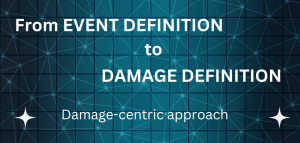By Pascal vander Straeten January 16, 2023
Due to the rapidly growing interconnectedness in every field of society, changing demographics, and increasing financialization, the world is fast becoming flat. Such a flat world leads also to more uncertainties, complexity, and volatility, and ultimately in the emergence of extreme risk events.
For investors, this issue is critical because more integration amongst markets means stronger co-movements between world markets, which negates the benefit of diversification across borders, as well as making investors more vulnerable to the caprices of global capital. In essence, I am referring here to volatility spillovers or, in other words, the financial contagion link between market integration/linkages and volatility.
The economic and behavioral analysis of extreme risk (or tail risk) enables us to understand the nature of extreme risk (or tail risk). By studying psychological perspectives on human decision making, risk assessment, and consumer behavior, behavioral economics can provide valuable insights into how individuals will respond to a more dangerous world. In contrast, traditional economic theory holds that human actions can be predicted based on the assumption that people always have complete information, are perfectly responsive to economic fluctuations, and are rational, meaning they always have stable, orderly preferences that always maximize their economic well-being. This view is seriously challenged by the occurrence of disasters. According to behavioral scientists, the 2007-2008 global financial crisis in the Western world highlights three critical elements where many economists and financiers have made incorrect predictions.
This is primarily because the human mind is not very adept at understanding low probability of occurrences, which leads to people not imaging that extreme risks might take place. For example, what does it mean to you if you live in a flood plain or an earthquake zone when you are told there is a one-in-100 chance you may encounter a disaster in the next year? Or, another example: how likely are you to comprehend a scenario whereby that the international order (western) which we have known since World War II would eventually undergo a metamorphosis? Alternatively, what are the chances that you accept the hypothetical idea of the European Union disappearing? In many cases, it is very difficult to translate such phenomena into action. Consequently, due to a lack of imagination, these dangers tend to be ignored or minimized and put on the back burner.
We also fail to learn from other people’s misfortunes. Once people have experienced intense emotions following a crisis (driven in part by social media coverage), their attention begins to wane. Not even ten years after the Great Recession, one of the most devastating systemic crises in Western history, the Trump administration repealed parts of the Dodd-Frank legislation. Those who had not personally experienced the GFC viewed the possibility of a financial disaster striking their markets again as so improbable that they could ignore it, and hence they thought that repealing part of Dodd Frank would do no harm. In spite of this, financial institutions in the West still are overleveraged and off-balance sheet activities remain an integral part of their operations.
Furthermore, research has proven that humans cannot fully comprehend the significance of disaster statistics. For instance, during the period 2008-2012, the Federal Deposit Insurance Corporation (FDIC) closed 455 failed banks in the U.S., but later found out it was 465. Would your brain recognize the difference? In contrast, in the five years prior to 2008, only ten banks failed. Further, people are more likely to relate to a bank they worked for previously than to a group of banks in crisis as a whole. According to conventional economic rationality, insensitivity to large financial losses violates the idea that we ought to care more about two firms suffering than one, and even more so about thousands of casualties.
Considering these observations, what lessons should decision-makers draw? Human reasoning frequently fails when it is most needed. Most of the time, intuitive and analytical thinking skills work beautifully in helping people navigate life. However, when the probability of catastrophic losses appears low enough that the risks can be ignored, these skills tend to fail. For those responsible for developing long-term strategies aimed at increasing the resilience of firms, understanding such behavioral quirks is of critical importance. Knowledge gained from decades of research on human behavior in the face of risk must be translated more systematically into actionable decisions. The goal is to overcome these obstacles to rationality. As a result, a more comprehensive approach to tail risk response needs to be established. The prevention of all future financial disasters is essential.
While I am aware that tail risk management, similar to traditional risk management, is seen by many Board members, or Top Management, as something that is merely required from a check-the-box compliance perspective, it remains, as a result, alas, not sufficiently seen as something that could contribute to the overall resilience of an organization. In addition, in relation to the risk management of tail (extreme) risks specifically, you often hear that members of the Board are not receiving the information necessary to determine whether the tail risks associated with an organization’s strategies are adequately managed. Alternatively, practitioners may not be able to obtain the support and resources they require for effective, mature tail risk management.
I believe that all of this is the result of an incorrect understanding of the notion of extreme risk and a miscomprehension of the controls necessary to manage tail risks at acceptable levels. Extreme risks nowadays are almost exclusively dealt with through the use of quantitative models (VaR, Expected Shortfall, CoVaR, Extreme Theory, etc.). As a result of this exclusive quantitative focus on “tail risk”, there is an insufficient emphasis on supplementary qualitative risk methods that would privilege notions of “resilience engineering” or “adaptability”. You can gain the attention of managers, executives, and board members not only by talking about how you can measure the likelihood and severity of a risk but also how you could make the entire organization more robust through resilience engineering.
The ultimate purpose of tail risk management should be about increasing an organization’s resilience when navigating through an uncertain and complex environment. And that is what resilience engineering is all about: it is about increasing the confidence level in achieving or exceeding objectives of the organization to acceptable levels or better, irrespective how complex and uncertain an environment can be. It is also relevant to note that tail risk practitioners use the language of business instead of technical risk/ audit terms. What language do you use when you are trying to convince a business development manager to embrace innovative ideas? Do you speak in his/ her language, or in some strange dialect that he/ she would not understand?
Imagine, hypothetically, an executive considering an investment program for a novel product that would be introduced in organization XYZ within the next few months. By supporting the investment program, the company would, in theory, be able to drive sales, gain a larger market share, and prevent rival companies from passing through the entry barrier. Management and business teams would then be required to understand how many emerging uncertainties impact the firm’s business model in order to succeed, right? Therefore, these uncertainties would need to be understood, assessed, and appropriate actions taken when necessary. There are a variety of tools available that could be used for this purpose, including risk mapping, early warning, principles of high reliability organizations, supply chain risk management, reverse stress testing, financial continuity planning, etc.
In other words, it is also necessary for management to have an acceptable degree of confidence that the investment program would be successful in order for the program to succeed. To achieve success, a number of things would need to take place: to increase the likelihood of positive events (and the size of the beneficial effects) and decrease the likelihood of negative events (and the size of the adverse effects).
From the setting of strategy to the management and operation of the business on a daily basis, tail risk events (low probability of uncertainty, but high severity of impact) needs to be taken into account in every decision. In spite of the fact that extreme events generally take a while to arrive, and while frequent monitoring should be performed, addressing them is typically not an everyday activity. A “tail risk” occurs when we fail to understand and address complexity and uncertainty by keeping our eyes off that horizon, resulting in poor decisions and failure to take necessary actions. In the absence of a clear view of the horizon, we may lose sight of our navigation route and end up where we did not intend to.
The bottom line is that unless we stop talking defensively about tail risk management (using the terminology of tail risk practitioners) and start talking about optimizing resilience engineering and adaptability in a positive manner (in the language of business), we will not succeed. As I understand it, building more resilient and adaptable business models should be the ultimate goal of any organization.







